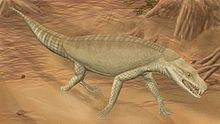Sphagesauridae
Genres de rang inférieur
- † Adamantinasuchus Nobre et Carvalho[1], 2006
- † Yacarerani Novas et al.[2], 2009
- † Caipirasuchus Iori et Carvalho[3], 2011
- † Sphagesaurus Price[4], 1950, genre type
- † Armadillosuchus Marinho et Carvalho[5], 2009
- † Caryonosuchus Kellner et al.[6], 2011
Les Sphagesauridae, les sphagesauridés en français, forment une famille éteinte de crocodyliformes, un clade qui comprend les crocodiliens modernes et leurs plus proches parents fossiles[7]. Il est rattaché au sous-ordre des Notosuchia (ou notosuchiens en français) et au clade des Ziphosuchia[8].
Ces Crocodyliformes terrestres, de 0,50 à 2 mètres de long, possèdent des mâchoires et des dents qui ressemblent à celles des mammifères, bien qu'ils ne soient pas liés à ce groupe.
Étymologie
[modifier | modifier le code]Le nom de la famille lui est donné par le genre type Sphagesaurus.
Description
[modifier | modifier le code]
d'Adamantinasuchus navae.

d'Armadillosuchus.

des trois différentes espèces du genre Caipirasuchus.
Ce sont des Crocodyliformes qui ont vécu sur le supercontinent du Gondwana à la fin du Crétacé supérieur, ils ne sont connus à ce jour qu'au Brésil entre le Turonien et le Maastrichtien, , soit il y a environ entre 93,9 et 66,0 millions d'années. Cinq des six genres proviennent de la formation géologique d'Adamantina, connue pour l'abondance de ses fossiles de vertébrés terrestres.
Liste des genres
[modifier | modifier le code]- † Adamantinasuchus Nobre et Carvalho[1], 2006. Formation d'Adamantina du Crétacé supérieur du Brésil, dont l'âge plus précis est discuté entre le Turonien et le Maastrichtien. Selon Judd A. Case en 2017[9], la formation daterait du Maastrichtien (au sommet du Crétacé supérieur), soit il y a environ entre 72,1 à 66,0 millions d'années ;
- † Yacarerani Novas et al.[2], 2009. Formation de Cajones du Brésil datée du Turonien au Santonien, soit il y a environ entre 93,9 à 83,6 millions d'années ;
- † Caipirasuchus Iori et Carvalho[3], 2011.Formation d'Adamantina du Crétacé supérieur du Brésil[9] ;
- † Sphagesaurus Price[4], 1950, genre type. Formation d'Adamantina du Crétacé supérieur du Brésil[9] ;
- † Armadillosuchus Marinho et Carvalho[5], 2009. Formation d'Adamantina du Crétacé supérieur du Brésil[9] ;
- † Caryonosuchus Kellner et al.[6], 2011. Formation d'Adamantina du Crétacé supérieur du Brésil[9].
Classification
[modifier | modifier le code]Les Sphagesauridae sont des Notosuchia placés dans le clade des Ziphosuchia[8].
Notes et références
[modifier | modifier le code]- (en) Pedro Henrique Nobre et Carvalho, Ismar de Souza, « Adamantinasuchus navae: A new Gondwanan Crocodylomorpha (Mesoeucrocodylia) from the Late Cretaceous of Brazil », Gondwana Research, vol. 10, nos 3-4, , p. 370–378 (DOI 10.1016/j.gr.2006.05.008, lire en ligne [archive du 6 de julio de 2011] [PDF])
- (en) F. E. Novas, Pais, D. F., Pol, D., Carvalho, I. D. S., Mones, A., Scanferla, A. et Riglos, M. S., « Bizarre notosuchian crocodyliform with associated eggs from the Upper Cretaceous of Bolivia », Journal of Vertebrate Paleontology, vol. 29, no 4, , p. 1316–1320 (DOI 10.1671/039.029.0409, lire en ligne)
- (en) F. V. Iori et I. S. Carvalho, « Caipirasuchus paulistanus, a new sphagesaurid (Crocodylomorpha, Mesoeucrocodylia) from the Adamantina Formation (Upper Cretaceous, Turonian–Santonian), Bauru Basin, Brazil », Journal of Vertebrate Paleontology, vol. 31, no 6, , p. 1255 (DOI 10.1080/02724634.2011.602777)
- (en) Price LI. 1950. On a new crocodilian, Sphagesaurus, from the Cretaceous of the State of São Paulo, Brazil. Anais da Academia Brasileira de Ciências. 22 (1): 77-85
- (en) Thiago S. Marinho et Carvalho, Ismar S., « An armadillo-like sphagesaurid crocodyliform from the Late Cretaceous of Brazil », Journal of South American Earth Sciences, vol. 27, no 1, , p. 36–41 (DOI 10.1016/j.jsames.2008.11.005)
- (en) Alexander W. A. Kellner, Diogenes A. Campos, Douglas Riff et Marco Brandalise de Andrade, « A new crocodylomorph (Sphagesauridae, Notosuchia) with horn-like tubercles from Brazil », Zoological Journal of the Linnean Society, vol. 163, no s1, , S57–S65 (DOI 10.1111/j.1096-3642.2011.00712.x, lire en ligne)
- (en) M. Bronzati, F. C. Montefeltro et M. C. Langer, « A species-level supertree of Crocodyliformes », Historical Biology, , p. 1 (DOI 10.1080/08912963.2012.662680)
- (en) D. Pol, P. M. Nascimento, A. B. Carvalho, C. Riccomini, R. A. Pires-Domingues et H. Zaher, « A New Notosuchian from the Late Cretaceous of Brazil and the Phylogeny of Advanced Notosuchians », PLoS ONE, vol. 9, no 4, , e93105 (PMID 24695105, PMCID 3973723, DOI 10.1371/journal.pone.0093105)
- (en) « Age of the Adamantina formation, upper Bauru group, Late Cretaceous, Brazil »
Voir aussi
[modifier | modifier le code]Références taxinomiques
[modifier | modifier le code](en) Référence Paleobiology Database : Sphagesauridae Kuhn, 1968
